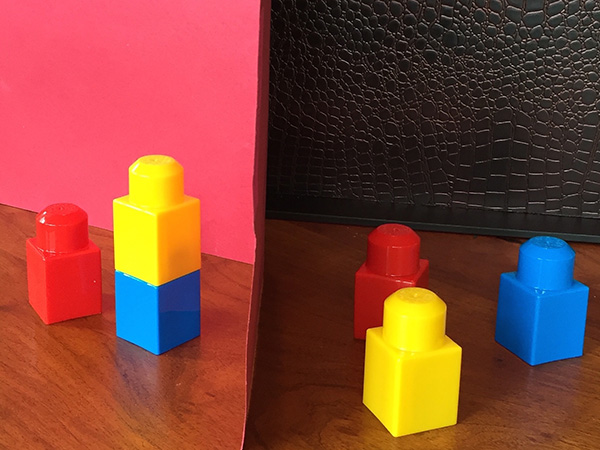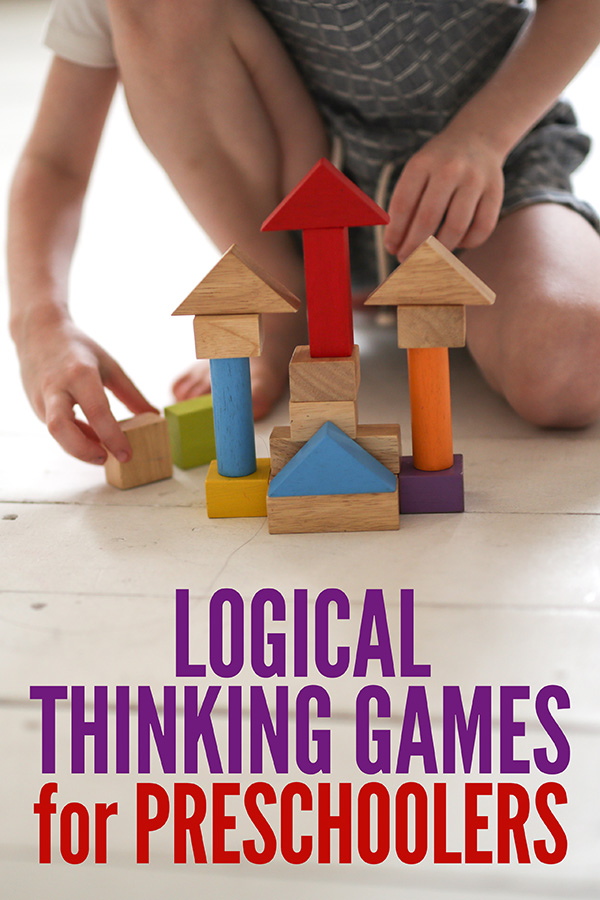5 Logical Thinking Games for Preschoolers
Inside: 5 fun, logical thinking games for preschoolers.
If you’ve ever tried to reason with a three-year-old, you know that a child at this age is not a logical thinker. Young children are very concrete and literal in their thinking, and it is only as they approach school age that they begin to show a readiness for tasks that require more abstract thinking. However, preschoolers often make surprising connections as they go about the business of learning and making sense of the world, and there are some fun logical thinking games for engaging your preschooler’s brain in new ways of thinking!
What is Logical Thinking?
Logical thinking involves reasoning and using what you know to draw conclusions. It requires an understanding of attributes, relationships, and sequence, and is not only important for formal learning; it is an essential life skill. According to Ellen Galinsky, author of Mind in the Making, learning to use higher-order thinking skills will positively impact your child’s success in many areas of life.
Looking for ideas for older children? Check out this collection of Brain Games and Logic Puzzles that get kids thinking.
5 Logical Thinking Games for Preschoolers
The five games below integrate logical thinking skills into play. As you introduce a new game, be sensitive to how engaged and interested your child is in the activity, and maintain a playful tone and demeanor. If your child isn’t quite ready for an activity, try it again in a few weeks or months.
1. Twin Towers
For this game, you will need building blocks, coloured cubes, or Lego®. Position your child across from you on the floor or at a table, and place a tall box or folder between you so that your child cannot see what you are building on your side.
Beginning with two blocks of two different colours, build a tower and explain the game to your child this way: “I just built a tower of two blocks. I used a blue one and a yellow one. Can you try to build a tower just like mine? I’ll give you hints.” Knowing your child’s level of understanding, begin giving clues such as: “The blue block is on the bottom” and “The other block is on top.”
If your child is successful in building a “twin tower,” try making the clues more difficult by using the word “NOT.” Example: “The blue block is NOT on top.” Understanding this kind of clue requires a different level of thinking, and may be too challenging. If so, keep the clues straightforward and simple, and instead add challenge by using more blocks of varying colours and building taller towers.
RELATED: Blocks and constructions sets are fabulous for developing logical thinking and problem solving skills. Check out our collection of 21 awesome building kits and sets for children of all ages.
2. Hide and Seek With a Twist
Most preschoolers love the game Hide and Seek. In this version, your child hides a toy or stuffed animal somewhere in your house, and you ask questions about where it is hidden. Your child nods or shakes his head to indicate answers. Ask questions such as, “Is it hidden in a room someone sleeps in?” “Is it hidden where someone sits?” “Is it hidden near a wall?” This requires your child to think about each clue and consider whether it is TRUE or FALSE based on where the object is hidden.
Younger children will not always give you the correct responses, so keep track of the questions asked. When the object is found, avoid correcting any errors in clues, and instead review them out loud: “Oh, it WAS hidden where someone sits, but it WAS NOT hidden where someone sleeps!” Even if your child is not yet responding appropriately, you are using the vocabulary of logical thinking while you are having fun!
3. Line Up the Toys
This game requires your child to think about both order and attributes. To play, you need four or five toys or small stuffed animals and, for extra fun, your smartphone. When your child isn’t looking, place the toys or animals in a line, as if they are lined up to go someplace. You can lay out papers as placeholders, even numbering them if you choose. Once the toys are in order, take a picture with your phone. Then move the toys back away from their positions.
Call your child over, saying, “Would you like to play a guessing game?” Ask your child to place the toys or animals in a line according to your directions, using clues that require more thinking than “first, next, last..” For example, you could say, “I put the toy with the wheels first in line.” “The animal with spots is last in line.” “The toy with long ears is behind the car,” etc.
To reward success, show your child the photo you took and compare with their line-up. Eventually, your child might enjoy switching roles and giving you directions.
4. Double Side Shape & Colour Game
This wooden puzzle does considerably more than reinforce the attributes of shape and colour. It requires the player to use the skills of sequencing, cause-and-effect, and deduction and has great versatility. It can be introduced as a one-player activity and, as your child is ready, played with two players. Also a hit with children beyond preschool age, this game reinforces all the skills of logical thinking in an entertaining way.
5. Little Red Riding Hood Game
An award-winning game that includes a picture book and multi-level challenges, your preschooler will enjoy this one for many years. The goal is to make a path for Little Red Riding Hood so that she can get to Grandma’s house, and along with visual perception and spatial reasoning, the skills of planning and problem solving are practised and reinforced. Your child will use many thinking skills, and will enjoy the satisfaction of successfully achieving the goal!




